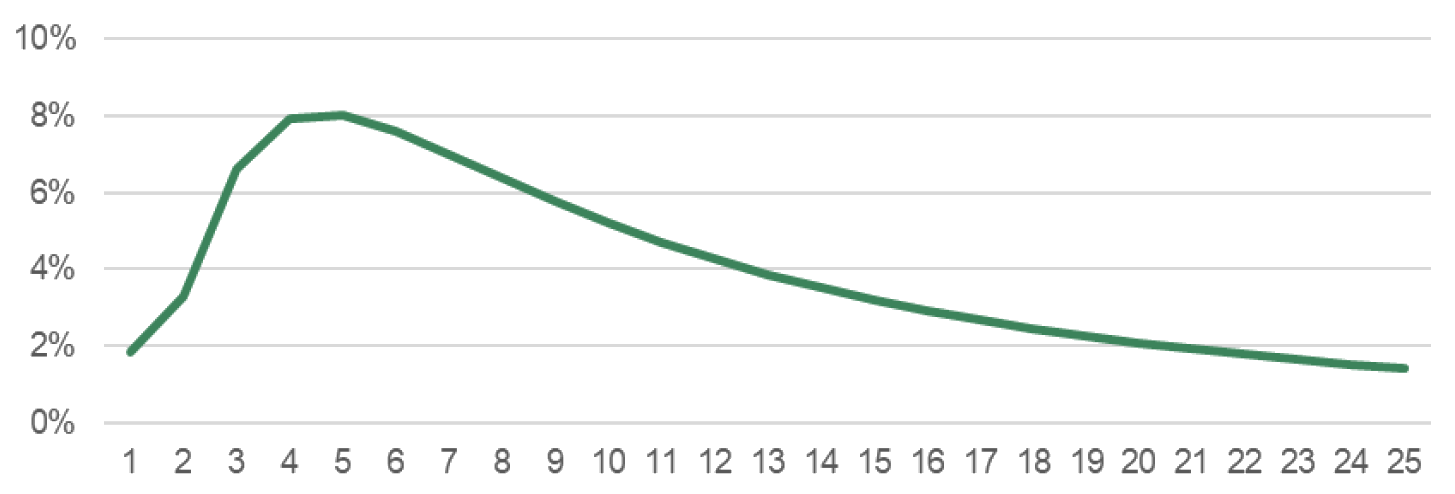Did you know that planting your trees in the initial years of a carbon project can potentially help to avoid crediting reductions?
Let’s start with a side note…
Here at the CFF, we specialise in the compliance and project management piece of the carbon farming puzzle. And while we can provide remote compliance and technical advice, it’s not our role to provide agronomic or forestry specialist advice for your project.
We suggest that before you plant trees on your property, you engage a local forester who will be able to provide expert advice on when you should plant your trees.
So how are the carbon yields calculated if I decide to plant trees on my property?
We’re glad you asked! To answer this, we need to go back a few steps to explain the Australian Carbon Credit Unit (ACCU) Scheme and its FullCAM modelling tool.
If you want to generate Australian Carbon Credit Units (ACCUs) as part of an Environmental Planting Carbon project, you need to register your project under the Reforestation by environmental or mallee plantings FullCAM methodology.
Similarly, if you want to generate Australian Carbon Credit Units (ACCUs) as part of a Plantation Forestry project, you need to register your project under the Plantation Forestry Method.
Projects under these methodologies store carbon in trees as they grow, earning carbon credits over a 25-year crediting period. For every tonne of CO2e stored, you earn one carbon credit.
The estimated carbon stock that will be stored in your project’s trees, shrubs and debris across a 25-year crediting period is calculated in advance using a computer modelling tool known as the Full Carbon Accounting Model (FullCAM). We provide a more in-depth explanation of how FullCAM works in our blog here.
Provided your tree planting complies with the methodology requirements, you will be paid for FullCAM-modelled carbon, rather than real-time measurement of carbon sequestration. This means you know exactly what your carbon yields will be before you start your project.
Wait…what is a crediting period? And is this the same as a permanence period?
Not quite. The crediting period is the time frame in which you are issued your carbon credits. The crediting period is always 25 years across all ACCU Scheme carbon farming methodologies and, in the case of an environmental planting project, starts from the day you commence planting your trees in the ground.
The permanence period is a bit different. It’s the time period that you need to commit to running a carbon project and it can be either 25 years or 100 years and starts from the submission of your first offset report.
However, regardless of whether your permanence period is 25 or 100 years, you will be paid your entire bank of carbon credits across the 25-year crediting period.
Ok, then why does planting trees early affect the yields so much?
Put simply, the longer your trees are in the ground, the larger they can grow. With time and size, they can store more carbon, generating higher carbon yields and accruing more carbon credits.
And as your crediting period is capped at 25 years and starts from the day you plant your first trees, the earlier all your trees are in the ground the more creditable time they will have.
Reminder…
To receive your ACCUs, your tree growth needs to be checked and verified in reporting cycles that take place at least every five years, as well as audited regularly. Once you’ve completed your reporting round (also known as Offset Reports), and your project is deemed compliant by an independent auditor, the issuance of your carbon credits will be triggered.
Let us introduce you to the carbon yield curve
Understanding the carbon yield curve, exampled in Figure 1 below, can help you understand why planting your trees early can generate better lifetime returns. Under FullCAM, each tree planting has a given amount of carbon ‘potential’ that it can be credited for over the 25-year crediting period. This amount reduces with every year that passes. Basically, every year you don’t have trees in the ground, you will be missing out on carbon revenue.
The carbon yield curve in Figure 1 below shows the first few years of modelled growth are modest but by years 4 and 5 you can expect peak annual yields, trailing off over for the remainder of the crediting term. This means that 60% of your carbon credits will usually be issued within the first 10-year period.
Keeping this in mind, planting your trees earlier in the piece means you utilise the crediting period as best possible, thus ensuring maximum returns.

Figure 1: Annual carbon Yield Curve for a Native Tree Carbon Project
Can you show me an example of the benefits of planting early?
Of course! To help us further understand this, we built out a FullCAM modelling simulation and compared the carbon yields across planting over multiple years*. We crunched the numbers for an example Environmental Planting Project, and it came back with the following results.
Example: Farm ABC
Project Overview: A 200-hectare Environmental Planting Project located in northwest Victoria
We picked a random point on Farm ABC and ran our modelling to crunch the potential carbon yields. Here’s what it came back with.
If Farm ABC plants in:
Year 1 they can expect a yield of 107tCO2e per Ha
Year 3 they can expect a yield of 101tCO2e per Ha
Year 10 they can expect a yield of 81tCO2e per Ha
Whilst the yields don’t appear vastly different between each year if we apply this to a hypothetical project of 200 hectares and compare planting in different years, this is how it differs financially.
Table 1: Difference in carbon yields when you plant in different years across a 200-hectare project
| Year Planted | Percentage of tCO2e yielded | Number of tCO2e yielded | Potential Profits ($20 ACCU Spot Price) | Potential Profits ($30 ACCU Spot Price) | Potential Profits ($40 ACCU Spot Price) |
| Year 1 | 100% | 21,400 | $428,000 | $642,000 | $856,000 |
| Year 3 | 94% | 20,200 | $404,000 | $606,000 | $808,000 |
| Year 10 | 75% | 16,200 | $324,000 | $486,000 | $648,000 |
As you can see, it makes a lot more sense financially to plant your trees in the first year of your project.
*The discount percentage used when completing a model for feasibility is an average and may differ for your property’s carbon yields
Ok… I see your point. But the proposed scale of my project means that I logistically can’t plant all my trees in the first year. What should be my game plan?
A valid point! Depending on your existing farming operation and how many trees you want to plant, numerous factors may require you to stagger your planting over multiple years. Some examples are:
- Nursery availability
- Contractor availability
- Budgetary restrictions
- Weather events
- Key planting window
If it looks like you’re going down the larger project route, you can be strategic in how you stagger your annual plantings across your property. For example, in some scenarios, we suggest planting in the higher carbon-yielding areas first if possible, and lower yielding areas later, to reduce carbon yield loss.
It’s important to note that this information is given with the assumption that the entire project area to be planted will be registered with the ACCU Scheme from the outset of the project. We understand that there are scenarios where it is tricky to nail down the set project area at the time of registering the project.
Keeping this in mind, the CFF can help you work out your ideal planting design, project registration game plan and modelling options to generate optimal carbon yields, as well as making that your project stays compliant with the ACCU Scheme.
Ok, that clears things up…so what are my next steps?
One of our Project Facilitators can run a back-of-envelope analysis to provide a high-level estimate of the carbon yield on each hectare of your property. Email us at [email protected] or give us a bell at (08) 6835 1140 to be connected with one of our project facilitators.
Ready to find out more?
Explore our range of educational resources in our Carbon Farming Education Hub where we frequently publish educational articles, webinars, and guidebooks.


![AFN – Cert Accredited Expert [RGB] AFN - Cert Accredited Expert [RGB]](https://carbonfarming.org.au/wp-content/uploads/elementor/thumbs/AFN-Cert-Accredited-Expert-RGB-e1725255016744-qti2uogw4b9a3s6au2d1bbf4utb8ggjuwvkj4qpce8.png)